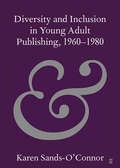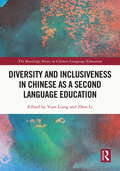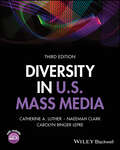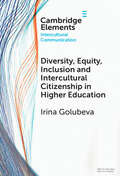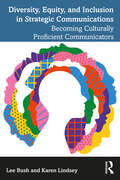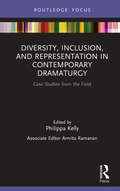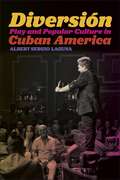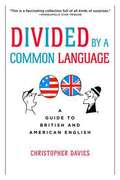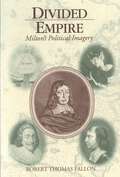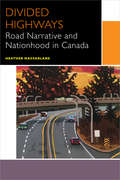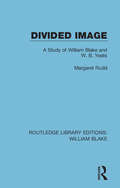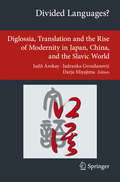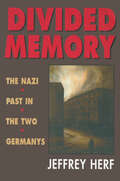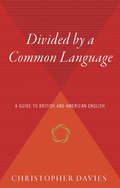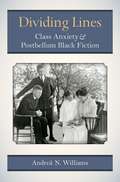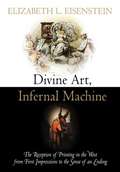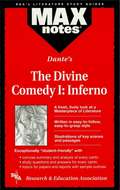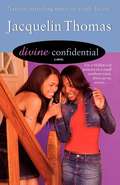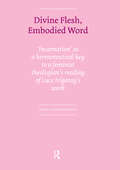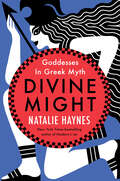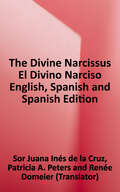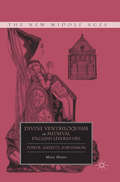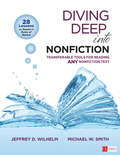- Table View
- List View
Diversity and Inclusion in Young Adult Publishing, 1960–1980 (Elements in Publishing and Book Culture)
by Karen Sands-O'ConnorThis Element examines the early years of British Young Adult (YA) publishing at three strategic publishing houses: Penguin, Heinemann and Macmillan. Specifically, it discusses their YA imprints (Penguin Peacocks, Heinemann New Windmills and Macmillan Topliners), all created at a time when the population of Britain was changing and becoming more diverse. Migration of colonial and former colonial subjects from the Caribbean, India, and Africa contributed to a change in the ethnic makeup of Britain, especially in major urban centres such as London, Birmingham and Manchester. While publishing has typically been seen as slow to respond to societal changes in children's literature, all three of these Young Adult imprints attempted to address and include Black British and British Asian readers and characters in their books; ultimately, however, their focus remained on white readers' concerns.
Diversity and Inclusiveness in Chinese as a Second Language Education (The Routledge Series on Chinese Language Education)
by Zhen LiThis edited volume represents a collaborative effort from over 20 authors worldwide, who generously shared their expertise and insights on diversity and inclusiveness in Chinese as a Second Language (CSL) education. It critically examines a wide range of acquisitional, curricular, and pedagogical issues related to inclusive practices in diverse CSL educational settings across various geographical contexts, including mainland China, Hong Kong, Taiwan, Singapore, Vietnam, the United Kingdom, and Australia. It focuses on students with varied linguistic, ethnic, and cultural backgrounds and learning abilities, drawing on a comprehensive collection of original empirical studies.The book is structured into two parts. Part I addresses research on linguistic and learner diversity in CSL education by exploring the challenges faced by different types of CSL learners, acquisition strategies, and assessment methods. Part II delves into the practical implementation of inclusivity in curriculum design and pedagogical practices across diverse CSL teaching contexts.The book offers a research-informed understanding of diversity in CSL education, promoting inclusive teaching practices and methods to effectively engage learners of all backgrounds. CSL practitioners, educators, leaders, curriculum designers, and researchers will find this book to be a useful resource for supporting their research and practice.
Diversity in U.S. Mass Media
by Catherine A. Luther Naeemah Clark Carolyn Ringer LepreProvides students with clear and up-to-date coverage of the various areas associated with representations of diversity within the mass media Diversity in U.S. Mass Media is designed to help undergraduate and graduate students deepen the conversations around diversity, equity, and inclusion in the media industries. Identifying consistencies and differences in representations of social identity groups in the United States, this comprehensive textbook critically examines a wide range of issues surrounding media portrayals of race, ethnicity, gender, sexual orientation, disability, age, class, and religion. Throughout the text, students are encouraged to contextualize various issues, place one social group within the framework of others, and consider how diverse communities inform and intersect with each other. Now in its third edition, Diversity in U.S. Mass Media addresses ongoing problematic portrayals, highlights recent progress, presents new research studies and observations, and offers innovative approaches for promoting positive change across the media landscape. Two entirely new chapters explore the ways identity-based social movements, Artificial Intelligence (AI), gaming, social media, and social activism construct, challenge, and defend representations of different groups. Updated references and new examples of social group depictions in streaming services and digital media are accompanied by expanded discussion of intersectionality, social activism, creating inclusive learning and working environments, media depictions of mixed-race individuals and couples, and more. Offering fresh insights into the contemporary issues surrounding depictions of social groups in films, television, and the press, Diversity in U.S. Mass Media: Examines the historical evolution and current media depictions of American Indians, African Americans, Latino/Hispanic Americans, Arab Americans, and Asian Americans Helps prepare students in Journalism and Mass Communication programs to work in diverse teams Covers the theoretical foundations of research in mass media representations, including social comparison theory and feminist theory Contains a wealth of real-world examples illustrating the concepts and perspectives discussed in each chapter Includes access to an instructor's website with a test bank, viewing list, exercises, sample syllabi, and other useful pedagogical tools Diversity in U.S. Mass Media, Third Edition, remains an ideal textbook for upper-level undergraduate and graduate courses in Media Communication, Film and Television Studies, Journalism, American Studies, Entertainment and Media Research, and Diversity, Equity, and Inclusion (DEI).
Diversity, Equity, Inclusion and Intercultural Citizenship in Higher Education (Elements in Intercultural Communication)
by Irina GolubevaTraditionally, the fields of Diversity, Equity, and Inclusion (DEI) and Intercultural Citizenship Education (ICitE) have been treated separately in Higher Education (HE) and beyond, with DEI often being associated with domestic diversity, while ICitE is often situated within international contexts. Although such binary perception is no longer adequate due to the superdiversity that characterizes today's university communities, the origins of this categorical distinction can be explained through an examination of the disciplinary roots, theoretical foundations, primary focus, and implementation approaches. Despite this difference in perspectives between the two fields, the Element argues that DEI and ICitE can complement each other in a variety of positive and productive ways. It does so by identifying the intersections between these two distinct yet interrelated fields and by providing an example of how they can be intentionally synergized in HE practice.
Diversity, Equity, and Inclusion in Strategic Communications: Becoming Culturally Proficient Communicators
by Karen Lindsey Lee BushTaking a DEI-first approach, this book teaches students to become culturally proficient communicators by approaching diversity, equity, and inclusion (DEI) with intentionality in every aspect of strategic communications. Those who work in strategic communications play a powerful role in shaping public perceptions and thus have a crucial responsibility to understand and practice the principles of diversity, equity, and inclusion in their work. This book introduces students to DEI theories and concepts and guides them through applying these concepts to communications research, planning, and execution. Chapters in the book align with the courses and competencies most often taught in advertising and public relations programs. It also includes chapters on “Inclusive Leadership” and “Working on Diverse Teams,” as students will need these competencies when working on group class projects and in preparing for internships. The concluding chapter on “Communicating for Social Change” allows students to look beyond advertising and PR as corporate-centered disciplines and expand their understanding of the power of communications to advocate for social justice and change. Ideal for students at the undergraduate level with relevance to graduate students as well, the book can be used as a stand-alone text in DEI communications courses, as a supplement to core advertising or public relations texts, or in modules in advanced communications courses. Online materials for instructors include teaching tips, suggested discussions and activities, student assignments, sample quizzes, and video links. They are available at www.routledge.com/9781032533865.
Diversity, Inclusion, and Representation in Contemporary Dramaturgy: Case Studies from the Field (Focus on Dramaturgy)
by Philippa Kelly Amrita RamananDiversity, Inclusion, and Representation in Contemporary Dramaturgy offers fresh perspectives on how dramaturgs can support a production beyond rigid disciplinary expectations about what information and ideas are useful and how they should be shared. The sixteen contributors to this volume offer personal windows into dramaturgy practice, encouraging theater practitioners, students, and general theater-lovers to imagine themselves as dramaturgs newly inspired by the encounters and enquiries that are the juice of contemporary theater. Each case study is written by a dramaturg whose body of work explores important issues of race, cultural equity, and culturally-specific practices within a wide range of conventions, venues, and communities. The contributors demonstrate the unique capacity of their craft to straddle the ravine between stage and stalls, intention and impact. By unpacking, in the most up-to-date ways, the central question of “Why this play, at this time, for this audience?,” this collection provides valuable insights and dramaturgy tools for scholars and students of Dramaturgy, Directing, and Theater Studies.
Diversión: Play and Popular Culture in Cuban America (Postmillennial Pop #18)
by Albert Sergio LagunaWinner, 2018 Peter C. Rollins Book Prize, presented by the Northeast Popular/American Culture Association Winner, 2018 Robert K. Martin Book Prize, presented by the Canadian American Studies AssociationHonorable Mention, 2019 Outstanding Book Award, given by the Latina/o Studies Section of the Latin American Studies AssociationA re-examination of the Cuban diaspora through the lens of popular culture. In an era of warming relations between the US and Cuba, this book updates the conversation about Cuban America by showing how this community has changed over the past 25 years. No longer a conservative Republican voting bloc, the majority of Cubans today want more engagement with the island instead of less. Laguna investigates the generational shifts and tensions in a Cuban America where the majority is now made up of immigrants who arrived since the 1990s and those born in the US. To probe these changes, Laguna examines the aesthetic and social logics of a wide range of popular culture forms originating in Miami and Cuba from the 1970s through the 2010s. They include the stand-up comedy of performers like Alvarez Guedes and Robertico, a festival called Cuba Nostalgia, Miami morning radio shows, a form of media distribution on the island known as el paquete, and the viral social media content of Los Pichy Boys. This study illustrates the centrality of play in a community that has been described historically as angry, reactionary, and melancholic. Diversión contends that our understanding of the Cuban diaspora is lacking not in seriousness, but in play. By unpacking this archive, Laguna explores our complex, often fraught attachments to popular culture and the way it can challenge and reproduce typical cultural ideologies—especially in relation to politics and race. In the wake of the largest migration wave to the US in Cuban history, Diversión and its focus on play is crucial reading for those who seek to understand not only the Cuban American diaspora, but cultural and economic life on the island.
Divided By A Common Language: A Guide To British And American English
by Christopher DaviesPuzzled by signs warning you to "mind the gap" in the London Underground? Wondering what will be on your plate if you order "toad in the hole" in a London café? In Divided by a Common Language, Christopher Davies explains these expressions and discusses the many differences in pronunciation, spelling, and vocabulary between British and American English. He compares the customs, manners, and practical details of daily life in the United Kingdom and the United States, and American readers will enjoy his account of American culture as seen through an Englishman's eyes. Davies tops it off with an amusing list of expressions that sound innocent enough in one country but make quite the opposite impression in the other. Two large glossaries help travelers translate from one variety of English to the other, and additional lists explain the distinctive words of Australia, New Zealand, and South Africa. Divided by a Common Language is the ideal travel companion for both British visitors to the U. S. and American visitors to the U. K. It is also the perfect book for Britons interested in American culture and Americans enjoying British novels, movies, and television at home.
Divided Empire: Milton's Political Imagery
by Robert Thomas FallonIn Divided Empire, Robert T. Fallon examines the influence of John Milton's political experience on his great poems: Paradise Lost, Paradise Regained, and Samson Agonistes. This study is a natural sequel to Fallon's previous book, Milton in Government, which examined Milton's decade of service as Secretary for Foreign Languages to the English Republic.Milton's works are crowded with political figures—kings, counselors, senators, soldiers, and envoys—all engaged in a comparable variety of public acts—debate, decree, diplomacy, and warfare—in a manner similar to those who exercised power on the world stage during his time in public office. Traditionally, scholars have cited this imagery for two purposes: first, to support studies of the poet's political allegiances as reflected in his prose and his life; and, second, to demonstrate that his works are sympathetic to certain ideological positions popular in present times.Fallon argues that Paradise Lost is not a political testament, however, and to read its lines as a critique of allegiances and ideologies outside the work is limit the range and scope of critical inquiry and to miss the larger purpose of the political imagery within the poem. That imagery, the author proposes, like that of all Milton's later works, serves to illuminate the spiritual message, a vision of the human soul caught up in the struggle between vast metaphysical forces of good and evil. Fallon seeks to enlarge the range of critical inquiry by assessing the influence of personal and historical events upon art, asking, as he puts it, "not what the poetry says about the events, but what the events say about the poetry." Divided Empire probes, not Milton's judgment on his sources, but the use he made of them.
Divided Highways: Road Narrative and Nationhood in Canada (Canadian Literature Collection)
by Heather MacfarlaneThe road trip genre, well established in the literatures of Canada, is a natural outcome of the nation’s obsession with geography. Divided Highways examines road narratives by Anglo-Canadian, Québécois and Indigenous authors and the sense of place and nationhood in these communities. Geography describes the land, and history peoples it, just as memories connect us to place. This is why road trips are such a feature of writing in Canada, allowing the travellers to claim, at least symbolically, the terrain they have traversed. Macfarlane examines works by a variety of writers from each of these communities, including Gilles Archambault, Jeannette Armstrong, Jill Frayne, Tomson Highway, Claude Jasmin, Robert Kroetsch, Jacques Poulin, Aritha van Herk and Paul Villeneuve, to name but a few. Studying a diversity of road narratives from Anglo-Canadian, Québécois and Indigenous populations not only demonstrates the existence of a very specific road genre, but is also revelatory of very diverse and often conflicting perceptions of nationhood. It is these expressions of sovereignty that are integral to ongoing discussions of reconciliation and decolonization. This book is published in English. - Cet ouvrage étudie l’existence et la tradition du roman de la route au Canada. La géographie décrit le territoire et l’histoire lui insuffle vie, tout comme les souvenirs sont des points d’attache à un lieu donné. Voilà pourquoi les road trips ont une place privilégiée dans l’écriture d’expression anglaise, française et autochtone du Canada : ils permettent aux voyageurs de revendiquer, du moins symboliquement, le terrain qu’ils ont couvert. C’est l’intersection de l’histoire et de la géographie qui confère toute sa signification à un voyage, qui alimente cet esprit des lieux, ou qui permet d’en constater l’absence. Les voyages sont révélateurs des intérêts propres aux trois groupes examinés dans le cadre de cette étude. Le désir, et parfois la nécessité, d’entreprendre un voyage, les compagnons de voyage ainsi que les destinations, de même que l’histoire qui s’écrit au fil des distances parcourues sont autant d’indicateurs de cette notion de l’espace et du concept de nation au sein du pays. Pour illustrer ce phénomène, ce livre examine des oeuvres littéraires d’une gamme d’écrivains anglophones, québécois et autochtones, dont Gilles Archambault, Jeannette Armstrong, Jill Frayne, Tomson Highway, Linda Hogan, Scott Gardiner, Claude Jasmin, Robert Kroetsch, Lee Maracle, Jacques Poulin, Aritha van Herk et Paul Villeneuve. L’approche comparative aux littératures du Canada est le prolongement logique aux études postcoloniales dans la mesure où elle révèle les complexités de même que les spécificités de diverses communautés, contribuant ainsi à une meilleure compréhension de collectivités nationales. Elle propose, en outre, des histoires qui font le contrepoids aux études transnationales. Ce livre est publié en anglais.
Divided Image: A Study of William Blake and W. B. Yeats (Routledge Library Editions: William Blake #No. 3)
by Rudd E. MargaretFirst published in 1953, this book examines Blake’s vision and its impact on the work of Yeats who imitated Blake in the hope that he might find that same vision. Margaret Rudd’s approach is literary as well as philosophical, and psychological and she discusses the work of both poets in this way.
Divided Languages?
by Judit Árokay Jadranka Gvozdanović Darja MiyajimaThe present volume is a collection of papers presented at the international conference "Linguistic Awareness and Dissolution of Diglossia" held in July 2011 at Heidelberg University. The aim is to reevaluate and compare the processes of dissolution of diglossia in East Asian and in European languages, especially in Japanese, Chinese and in Slavic languages in the framework of the asymmetries in the emergence of modern written languages. Specialists from China, Japan, Great Britain, Germany and the U. S. contributed to the volume by introducing their research focusing on aspects of the dissolution of diglossic situations and the role of translation in the process. The first group of texts focuses on the linguistic concept of diglossia and the different processes of its dissolution, while the second investigates the perception of linguistic varieties in historical and transcultural perspectives. The third and final group analyses the changing cultural role and function of translations and their effect on newly developing literary languages.
Divided Memory: The Nazi Past in the Two Germanys
by Jeffrey HerfA “valuable” study of how political narratives about the nation’s Nazi past differed in East and West Germany (The Wall Street Journal).A significant new look at the legacy of the Nazi regime, this book exposes the workings of past beliefs and political interests on how—and how differently—the two Germanys recalled the crimes of Nazism, from the anti-Nazi emigration of the 1930s through the establishment of a day of remembrance for the victims of National Socialism in 1996.Why, Jeffrey Herf asks, would German politicians raise the specter of the Holocaust at all, in view of the considerable support its authors and their agenda had found in Nazi Germany? Why did the public memory of Nazi anti-Jewish persecution and the Holocaust emerge, if selectively, in West Germany, while it was repressed and marginalized in “anti-fascist” East Germany? And how do the politics of left and right come into play in this divided memory? The answers reveal the surprising relationship between how the crimes of Nazism were publicly recalled and how East and West Germany separately evolved as a Communist dictatorship and a liberal democracy. This book, for the first time, points to the impact of the Cold War confrontation in both West and East Germany on the public memory of anti-Jewish persecution and the Holocaust.Konrad Adenauer, Theodor Heuss, Kurt Schumacher, Willy Brandt, Richard von Weizsacker, and Helmut Kohl in the West and Walter Ulbricht, Wilhelm Pieck, Otto Grotewohl, Paul Merker, and Erich Honecker in the East are among the many national figures whose private and public papers and statements Herf examines. His work makes the German memory of Nazism—suppressed on one hand and selective on the other, from Nuremberg to Bitburg—comprehensible within the historical context of the ideologies and experiences of pre-1945 German and European history as well as within the international context of shifting alliances from World War II to the Cold War. Drawing on West German and East German archives, this book is a significant contribution to the history of belief that shaped public memory of Germany’s recent past.“Groundbreaking . . . admirably subjects both East and West to equal scrutiny.” —Forward“[A] masterful book.” —German History
Divided by a Common Language: A Guide to British and American English
by Christopher DaviesThis guide to the language differences between the United States and United Kingdom is “a fascinating collection full of all kinds of surprises” (Minneapolis Star Tribune).Taxi rank . . . toad in the hole . . . dustman . . . fancy dress . . . American visitors to London (or viewers of British TV shows) might be confused by these terms. But most Britons would be equally puzzled by words like caboose, bleachers, and busboy. In Divided by a Common Language, Christopher Davies explains these expressions and discusses the many differences in pronunciation, spelling, and vocabulary between British and American English.He compares the customs, manners, and practical details of daily life in the United Kingdom and the United States, and American readers will enjoy his account of American culture as seen through an Englishman’s eyes. Davies tops it off with an amusing list of expressions that sound innocent enough in one country but make quite the opposite impression in the other. Two large glossaries help travelers translate from one variety of English to the other, and additional lists explain the distinctive words of Australia, New Zealand, and South Africa. This delightful book is the ideal companion for travelers—or anyone who enjoys the many nuances of language.
Dividing Lines: Class Anxiety and Postbellum Black Fiction
by Williams Andreá N.Dividing Lines is one of the most extensive studies of class in nineteenth-century African American literature. Clear and engaging, this book unveils how black fiction writers represented the uneasy relationship between class differences, racial solidarity, and the quest for civil rights in black communities. By portraying complex, highly stratified communities with a growing black middle class, these authors dispelled popular notions that black Americans were uniformly poor or uncivilized. But even as the writers highlighted middle-class achievement, they worried over whether class distinctions would help or sabotage collective black protest against racial prejudice. Andreá N. Williams argues that the signs of class anxiety are embedded in postbellum fiction: from the verbal stammer or prim speech of class-conscious characters to fissures in the fiction's form. In these telling moments, authors innovatively dared to address the sensitive topic of class differences—a topic inextricably related to American civil rights and social opportunity. Williams delves into the familiar and lesser-known works of Frances E. W. Harper, Pauline Hopkins, Charles W. Chesnutt, Sutton Griggs, and Paul Laurence Dunbar, showing how these texts mediate class through discussions of labor, moral respectability, ancestry, spatial boundaries, and skin complexion. Dividing Lines also draws on reader responses—from book reviews, editorials, and letters—to show how the class anxiety expressed in African American fiction directly sparked reader concerns over the status of black Americans in the U. S. social order. Weaving literary history with compelling textual analyses, this study yields new insights about the intersection of race and class in black novels and short stories from the 1880s to 1900s.
Divine Art, Infernal Machine: The Reception of Printing in the West from First Impressions to the Sense of an Ending
by Elizabeth L. EisensteinThe author has written a magisterial and highly readable account of five centuries of ambivalent attitudes toward printing and printers. Once again, she makes a compelling case for the ways in which technological developments and cultural shifts are intimately related.
Divine Comedy I: Inferno, The (MAXNotes Literature Guides)
by Anita Price DavisREA's MAXnotes for Dante's The Divine Comedy I: Inferno MAXnotes offer a fresh look at masterpieces of literature, presented in a lively and interesting fashion. Written by literary experts who currently teach the subject, MAXnotes will enhance your understanding and enjoyment of the work. MAXnotes are designed to stimulate independent thought about the literary work by raising various issues and thought-provoking ideas and questions. MAXnotes cover the essentials of what one should know about each work, including an overall summary, character lists, an explanation and discussion of the plot, the work's historical context, illustrations to convey the mood of the work, and a biography of the author. Each chapter is individually summarized and analyzed, and has study questions and answers.
Divine Confidential
by Jacquelin ThomasDivine is used to getting what she wants.... Thanks to her loving Aunt Phoebe and Uncle Reed, Divine Matthews-Hardison has a place to call home after the Hollywood life she was accustomed to fell apart at the seams. Getting away from the spotlight that nearly destroyed her own parents, Divine has changed for the better -- though there's still enough diva in Divine to keep life in Temple, Georgia, very lively, from mall shopping with her cousin Alyssa and her fashion-challenged aunt, to worshipping at her uncle's church, to dating. But what if it's too much too soon? Divine has boys on the brain and she's itching for a social life -- at least as much as is allowed under Uncle Reed's watchful eyes. She knows she's too young for the kind of secretive drama her cousin Chance is going through with his girlfriend, but still.... Turning to the internet, Divine gets a major crush on sixteen-year-old Sean, who sounds and looks like the perfect guy. But she is about to learn a difficult -- and potentially dangerous -- lesson: Things are not always what they appear to be....
Divine Discourse
by Nicholas WolterstorffProminent in the canonical texts and traditions of Judaism, Christianity, and Islam is the claim that God speaks. Nicholas Wolterstorff argues that contemporary speech-action theory, when appropriately expanded, offers us a fascinating way of interpreting this claim and showing its intelligibility. He develops an innovative theory of double-hermeneutics - along the way opposing the current near-consensus led by Ricoeur and Derrida that there is something wrong-headed about interpreting a text to find out what its author said. Wolterstorff argues that at least some of us are entitled to believe that God has spoken. Philosophers have never before, in any sustained fashion, reflected on these matters, mainly because they have mistakenly treated speech as revelation.
Divine Flesh, Embodied Word: Incarnation as a Hermeneutical Key to a Feminist Theologian's Reading of Luce Irigaray's Work (Vossiuspers UvA)
by Anne-Claire MulderWhat has Luce Irigaray’s statement that women need a God to do with her thoughts on the relation between body and mind, or the sensible and the intelligible?Using the theological notion ‘incarnation’ as a hermeneutical key, Anne-Claire Mulder brings together and illuminates the interrelations between these different themes in Luce Irigaray’s work. Seesawing between Luce Irigaray’s critique of philosophical discourse and her constructive philosophy, Mulder elucidates Irigaray’s thoughts on the relations between ‘becoming woman’ and ‘becoming divine’. She shows that Luce Irigaray’s restaging of the relation between the sensible and the intelligible, between flesh and Word, is key to her reinterpretation of the relation between woman and God. In and through her interpretation of Luce Irigaray’s thoughts on the flesh she argues that the relation between flesh and Word must be seen as a dialectical one, instead of as a dualistic relation. This means that ‘incarnation’ is no longer seen as a one-way process of Word becoming flesh, but as a continuing process of flesh becoming word and word becoming flesh. For all images and thoughts – including those of ‘God’ – are produced by the flesh, divine in its creativity inexhaustibility, in response to the touch of the other. And these images, thoughts, words in turn become embodied, by touching and moving the flesh of the subject.
Divine Might: Goddesses in Greek Myth
by Natalie HaynesNew York Times bestselling author Natalie Haynes returns to the world of ancient Greek myth in this scintillating follow-up to Pandora’s Jar.Few writers today have reshaped our view of the ancient Greek myths more than revered bestselling author Natalie Haynes. Divine Might is a female-centered look at Olympus and the Furies, focusing on the goddesses whose prowess, passions, jealousies, and desires rival those of their male kin, including:Athene, who sprang fully formed from her father’s brow (giving Zeus a killer headache in the process), the goddess of war and provider of wise counsel.Aphrodite, born of the foam (and sperm released from a Titan’s castrated testicles), the most beautiful of all the Olympian goddesses, the epitome of love who dispenses desire and inspires longing—yet harbors a fearsome vengeful side, doling out brutal punishments to those who displease her.Hera, Zeus’s long-suffering wife, whose jealousy born of his repeated dalliances with mortals, nymphs, and other goddesses, leads her to wreak elaborate and often painful revenge on those she believes have wronged her. (Well, wouldn’t you?)Demeter, goddess of the harvest and mother of Persephone; Artemis, the hunter and goddess of wild spaces; the Muses, the nine daughters of Zeus and Mnemosyne, the goddess of memory; and Hestia, goddess of domesticity and sacrificial fire.Infused with Haynes’s engaging charm and irrepressible wit, Divine Might is a refreshing take on the legends and stories we thought we knew.
Divine Narcissus/El Divino Narciso
by Sor Juana Ines de la Cruz Renee DomeierSor Juana Ins de la Cruz, known as The Tenth Muse of America, has been widely anthologized as a poet, intellectual, and defender of women's rights. Her calling as a nun, often denigrated or overlooked, is clear in The Divine Narcissus/El Divino Narciso, the finest extant example of the auto sacramental, a medieval genre similar to mystery plays. <P><P>Autos presented a blend of poetry, instrumental and choral music, dance and special effects and were intended to provide theological instruction to a broad audience. The Divine Narcissus is an allegory ostensibly written to explain Christian concepts to the Aztecs whose plight under colonization it also dramatizes. It reveals a scintillating display of sacred and secular knowledge. <P><P>Scholars and students in Spanish literature, colonial history, and women's studies will welcome this drama by Americas first feminist in its original Spanish and first English translation.
Divine Ventriloquism in Medieval English Literature
by Mary HayesA study of medieval attitudes towards the ventriloquism of God's and Christ's voices through human media, which reveals a progression from an orthodox view of divine vocal power to an anxiety over the authority of the priest's voice to a subversive take on the divine voice that foreshadows Protestant devotion.
Diving Deep Into Nonfiction, Grades 6-12: Transferable Tools for Reading ANY Nonfiction Text (Corwin Literacy)
by Michael W. Smith Jeffrey D. Wilhelm"General reading strategies and teacher-developed questions will only take our students so far—with our approach, students gain astounding independence because they engage directly with the nonfiction author, and with how that author used specific details (moves) and structures to communicate meanings and effects." —Wilhelm and Smith All nonfiction is a conversation between the writer and the reader, an invitation to agree or disagree with compelling and often provocative ideas about some aspect of the world we live in. At the end of the day, it’s our responsibility to decide if the argument is sound. With Diving Deep Into Nonfiction, Jeffrey D. Wilhelm and Michael W. Smith deliver a revolutionary teaching framework that helps students read well by noticing the rules and conventions of this dynamic exchange. The classroom-tested lessons include engaging short excerpts and teach students to be powerful readers who know both how authors signal what’s worth noticing in a text and how readers connect and make meaning of what they have noticed. No matter what they are reading, students learn to be on high alert, and highly curious about how texts work and what they mean, as they learn to notice direct statements of principle, calls to attention, ruptures, and readers’ rules of notice: Notice the topics and the textual conversation: Who is speaking and how might he or she be responding to another’s ideas? What is the idea that gives "heat" to this text? Notice key details: What attracts my attention? How does the author signal both direct and implicit statements of meaning? How does the author use the unexpected? How can I interpret patterns of key details to see overall meanings? Notice varied nonfiction genres: What are the essential features of this kind of text? How does the author employ them? What effects are they designed to have on the reader? Notice text structure: How does the author structure the text to connect details and ideas? What patterns of thought does the author use along the way? With Diving Deep Into Nonfiction, Wilhelm and Smith upend current practices, and it’s high time. Once your students engage with these lessons, you’ll never go back to the same old tired approach— and reading across content areas enters a whole new era.
Diving Deep Into Nonfiction, Grades 6-12: Transferable Tools for Reading ANY Nonfiction Text (Corwin Literacy)
by Michael W. Smith Jeffrey D. Wilhelm"General reading strategies and teacher-developed questions will only take our students so far—with our approach, students gain astounding independence because they engage directly with the nonfiction author, and with how that author used specific details (moves) and structures to communicate meanings and effects." —Wilhelm and Smith All nonfiction is a conversation between the writer and the reader, an invitation to agree or disagree with compelling and often provocative ideas about some aspect of the world we live in. At the end of the day, it’s our responsibility to decide if the argument is sound. With Diving Deep Into Nonfiction, Jeffrey D. Wilhelm and Michael W. Smith deliver a revolutionary teaching framework that helps students read well by noticing the rules and conventions of this dynamic exchange. The classroom-tested lessons include engaging short excerpts and teach students to be powerful readers who know both how authors signal what’s worth noticing in a text and how readers connect and make meaning of what they have noticed. No matter what they are reading, students learn to be on high alert, and highly curious about how texts work and what they mean, as they learn to notice direct statements of principle, calls to attention, ruptures, and readers’ rules of notice: Notice the topics and the textual conversation: Who is speaking and how might he or she be responding to another’s ideas? What is the idea that gives "heat" to this text? Notice key details: What attracts my attention? How does the author signal both direct and implicit statements of meaning? How does the author use the unexpected? How can I interpret patterns of key details to see overall meanings? Notice varied nonfiction genres: What are the essential features of this kind of text? How does the author employ them? What effects are they designed to have on the reader? Notice text structure: How does the author structure the text to connect details and ideas? What patterns of thought does the author use along the way? With Diving Deep Into Nonfiction, Wilhelm and Smith upend current practices, and it’s high time. Once your students engage with these lessons, you’ll never go back to the same old tired approach— and reading across content areas enters a whole new era.
